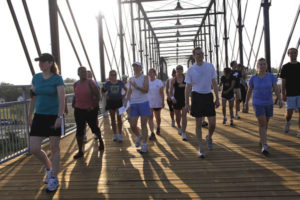This article was submitted to the Express-News by Tenna Florian, AIA, LEED AP, an architect with Lake/Flato Architects. She gives a great architectural history of the porch and also speaks to its cultural connection in historic neighborhoods. I couldn’t have said it any better myself.
Building San Antonio: It’s time to enjoy your front porch, S.A.
Sunday, May 1, 2011
San Antonio’s historic neighborhoods are full of houses with great front porches. If you are lucky enough to live in one of these homes, now is the time of year to enjoy your porch. The mornings are relatively cool, the afternoons are breezy, and perhaps most importantly, the mosquitoes are not yet out in full force.
More than any other architectural element, the front porch is perceived as a uniquely American element; however, ‘American’ inherently means a product of the cultural melting pot that helped form the many architectural styles found in this country.
The early Colonial period of architecture was mostly devoid of porches, since the majority of the immigrants during this time hailed from Europe, where porches were not common. However, as colonialism in Africa, India, and the Caribbean brought more Europeans into contact with a variation of styles, the front porch became more prevalent.
Another strong influence in the evolution of the American porch was the ‘shotgun house’ (a small, one-room-wide home), built by African slaves in the South. The front porch found in these early homes may have been evidence of African architectural tradition, but easily could have been a response to climate, living conditions, and the desire to be connected to the outdoors and surrounding community.
Eventually, in the 19th and early 20th centuries, the front porch came to represent cultural ideals of family, community, and nature. After dinner, families would retire to the front porch to cool off and socialize among themselves and with neighbors. An inherent sense of security was built in to this setting, as there were now more eyes on the street.
The sense of community that the porch represented declined in the mid-20th century, as more Americans owned their own automobiles and a more suburban way of living began to develop. As the prevalence of the air conditioned home increased, the need to either sit on the porch and cool off diminished. Entering the home through the front door became a rarity as the popularity of the attached garage, which served as a back door point of entry, increased. The garage replaced the porch as the primary architectural feature, in relation to the street, of the front of a home.
But the front porch is making a comeback. A great front porch is seen as an asset when buying a historic home. There are also several new developments with design standards that require a home to have a front porch.
Sadly, many times these porches are more symbolic than they are functional. In order to be functional as more than a front stoop, a front porch should be at least deep enough to hold a chair with passing room in front, and at least wide enough for a porch swing, so that a family can sit comfortably on the porch and commune with nature and neighbors.
Whether you live in a bungalow in Beacon Hill or Mahncke Park, a Victorian Stick Style house in King William (or Lavaca), or any number of historic homes in central San Antonio neighborhoods, now is the time to open up your house, let the breeze come through, and enjoy your front porch.
While you are out there, be sure to acknowledge your neighbors that are also out, enjoying the night air.


